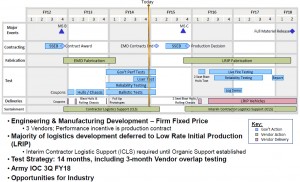
The Joint Tactical Light Vehicle (JLTV) program is moving forward on schedule – on Friday December 12, 2014, the US Army issued a final-version RFP for the procurement of 55,000 armored vehicles to three potential suppliers, clearing the way for AM General, Lockheed Martin, and Oshkosh Defense to submit their final proposals. Source selection is expected in July 2015 with a contract awarded to the winner next year as well.
“The JLTV program remains on track to deliver an affordable, protected-mobility solution that fills today’s critical capability gap with substantial advances in the balance of payload, performance, and protection,” Army Col. John Cavedo, the JLTV project manager, said in a statement. He said the program is on-budget. Both services expect to field their first JLTVs by 2018. Production will total 49,500 JLTVs for the Army and 5,500 for the Marines, with the production cycle ending sometime in the 2030s. Deliveries to the Marine Corps are expected to complete by 2022.
Balancing mobility, protection and payload, JLTV is meant to restore light tactical mobility
Following the Milestone C decision expected within a year, the Army will award a firm-fixed-price contract to a single vendor. The award period will cover three years of low rate initial production and five years of full-rate production, for a total of 17,000 vehicles for the Army and Marine Corps. The kits for those 17,000 will be produced by the selected OEM but follow-on kits might use a different vendor, the Army said. At a target price of US$250,000 per vehicle this phase could be worth over $4 billion.

The new vehicle will fill a gap between the High-Mobility, Multi-purpose Wheeled Vehicles (HMMWV) that serve the Army, the Marine Corps and nations throughout the world as their standard military vehicle since 1984 and the heavy and slow MRAPs that were introduced in some theaters since 2007.




















